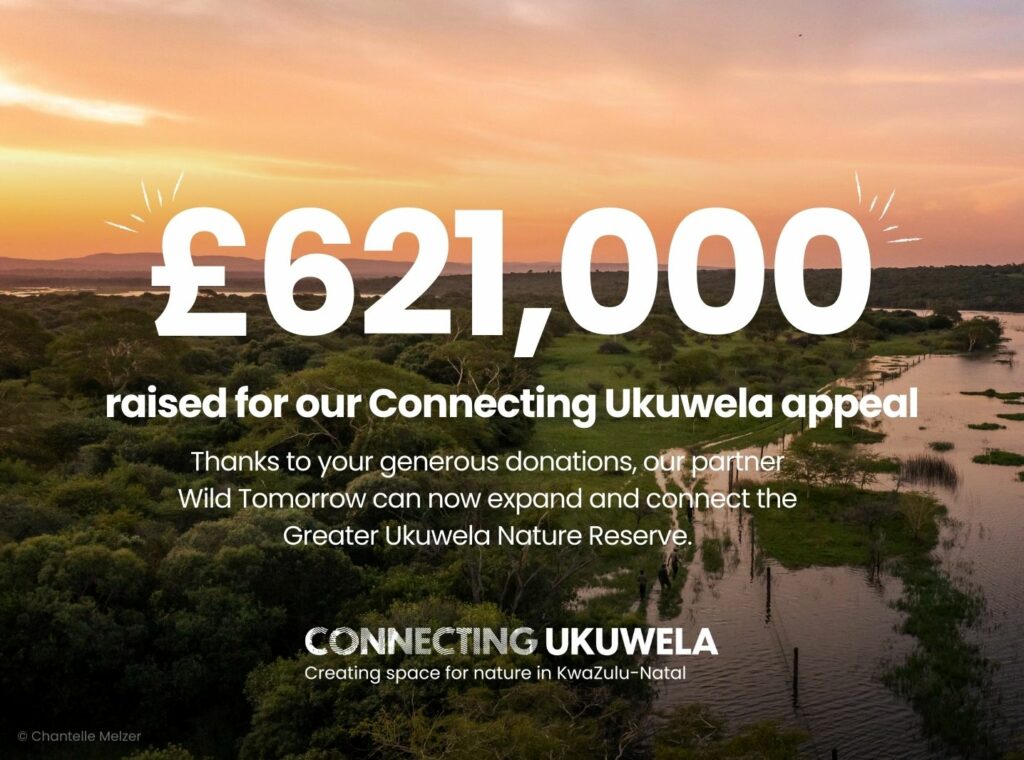Thanks to your support and generous donations, we’re delighted to announce that our South Africa’s Connecting Ukuwela appeal has reached its £621,000 target. Our partner Wild Tomorrow can now connect up and expand the Greater Ukuwela Nature Reserve (GUNR), forming a major wildlife corridor in KwaZulu-Natal.
The species and habitats of KwaZulu-Natal are incredibly biodiverse and unique, but are threatened by agriculture and timber production. In a time when protecting this region has never been more urgent, your donations will expand the Greater Ukuwela Nature Reserve (GUNR) by 148.5 hectares (367 acres).
What your donations will do
In 2021, Wild Tomorrow established the 1283-hectare (3170-acre) GUNR to connect two large neighbouring nature reserves. However, a critical piece of land was still needed to bridge the gap, Sisonke Farm.
With the help of supporters like you, Wild Tomorrow can now purchase Sisonke Farm and make this vision a reality. Your donations to our South Africa’s Connecting Ukuwela appeal will:
- Fund a 148.5-hectare (367 acre) expansion of the existing Greater Ukuwela Nature Reserve.
- Integrate Sisonke Farm into the GUNR, granting it permanent protection under South Africa’s Protected Areas Act.
- Create an unbroken thread of protected habitat from the Lebombo Mountains to the Indian Ocean.
- Support the continuation of Wild Tomorrow’s efforts empowering local communities, providing employment to rangers, and teaching in schools.
- Enable Wild Tomorrow to continue vital conservation management; restoring the critically endangered Dry Sand Forest, removing snares and invasive plants, and reintroducing species.
-
A home for threatened habitats and species
South Africa’s KwaZulu-Natal region is home to an extraordinary diversity of rare habitats and species, many of which aren’t found anywhere else on Earth. In fact, the GUNR is home to over 1200 species, several of which have only been recently recorded.
These include the Carruthers’ Rain Frog (Breviceps carruthersi) and the Phinda Button Spider (Latrodectus umbukwane). Both these species rely heavily on Dry Sand Forest, one of the world’s rarest subtropical forests. This precious and threatened habitat is also home for many rare ferns and orchids, such as the bizarre Pinhead Orchid (Microcoelia exilis) which, growing on the branches of trees, harvests light via its roots.
Alongside these unusual species, threatened birds of prey such as the Martial Eagle (Polemaetus bellicosus) and Southern Banded Snake Eagle (Circaetus fasciolatus) soar over the reserve’s many habitats, safe from human conflict and habitat loss. Only half of South Africa’s wetlands remain and the GUNR provides protection for Nile Crocodiles (Crocodylus niloticus) and Great White Pelicans (Pelecanus onocrotalus). On the savannah plains, you will find roaming packs of African Wild Dogs (Lycaon pictus) and one of Africa’s stealthiest hunters, the Leopard (Panthera pardus).
Each hectare that you help Wild Tomorrow save will give all these species and habitats the chance of a thriving future despite the ongoing threats they face.
A wildlife corridor for Africa’s living legends
John Steward, a Wild Tomorrow co-founder, says “this is a very exciting time. Thanks to your supporters, the GUNR will now become a major wildlife corridor for some of Africa’s most iconic species. This is something we’ve been planning for a long time”.
The GUNR will now connect the 27,923-hectare (69,000-acre) MunYaWana Conservancy to the northwest and the 331,842-hectare (820,000-acre) iSimangaliso Wetland Park to the east. The purchase of Sisonke Farm is about far more than 148.5 hectares, it is about recreating strong connections between habitats to give wildlife the space it needs to thrive.
Later this year, the MunYaWana Conservancy will drop their boundary fences, allowing Lions (Panthera leo), Black Rhinos (Diceros bicornis) and Elephants (Loxodonta africana) to enter the GUNR for the very first time. These large animals need a lot of land to roam and to flourish and now, thanks to your support, they will be able to do just that.
From all of us at WLT and Wild Tomorrow, we want to say a huge Thank You!
We are extremely appreciative of every single donation you have made to our Connecting Ukuwela appeal. The GUNR contains an extraordinary diversity of species and habitats, and your generosity will make a tangible difference to the people, plants and animals that live there.
Together we are actively securing a future for this extraordinarily precious and unique reserve.

